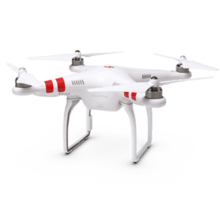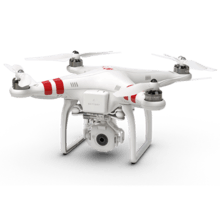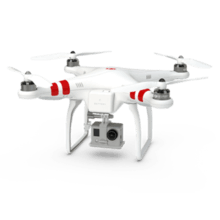Phantom (UAV)
 | |
 A Phantom 4 Professional drone | |
| Also known as | DJI Phantom |
|---|---|
| Developer | DJI |
| Manufacturer | DJI |
| Type | Unmanned aerial vehicle |
| Generation | 4 |
| Release date | January 2016 |
| Input | DJI GO and DJI Go 4 App |
| Camera | 1080p or 4K; onboard or gimbal-attached |
| Website | dji.com/phantom |
The Phantom (Chinese: 精灵; pinyin: Jīng Líng) is a series of unmanned aerial vehicles (UAVs) developed by Chinese technology company DJI.
The Phantom series is targeted toward commercial, amateur, and hobbyist use.
Current Phantom Drones
Phantom 4 Pro V2.0
The DJI Phantom 4 Pro V2.0, announced in May 2018, improves on the existing Phantom 4 Pro with an OcuSync transmission system, improved ESCs and low-noise propellers.[1]
It uses the same camera as the first iteration of the Phantom 4 Pro.[2]
This edition also features expanded Flight Autonomy with 5-direction obstacle sensing and 4-direction obstacle avoidance. The 6-camera navigation system means the aircraft can avoid obstacles in its flight path, whilst flying at speeds of up to 31mph. It’s also the very first DJI drone to feature an infrared sensing system.[3]
Phantom 4 Pro
DJI Phantom 4 Pro, released in November 2016, has a three-axis stabilized camera with a 1-inch 20 MP CMOS sensor. It upgrades its obstacle avoidance with five directional sensors. The Phantom 4 Pro offers two remote controllers, one with a dedicated screen (Phantom 4 Pro+) and one without. It integrates an upgraded Lightbridge HD video transmission system that adds 5.8 GHz transmission support and a maximum downlink video transmission range of 7 km.[4] In addition - DJI released a set of Goggles, which can be used with various DJI equipment, including the Phantom 4 Pro, to allow First Person View (FPV) flying.[5]
Phantom 4 Pro Obsidian
Announced at the 2017 IFA trade show, it gives the option to have the Phantom 4 Pro painted in obsidian black. Some build quality upgrades are included with the camera gimbal being made of magnesium.[6][7]
Phantom 4 Advanced
Announced on April 13, 2017, the Phantom 4 Advanced uses the same camera sensor as the Phantom 4 Pro.[8] Designed to replace the original Phantom 4, the Phantom 4 Advanced loses the 5.8Ghz frequency band, the rear vision sensors and two infrared sensors in the FlightAutonomy system in comparison to the Phantom 4 Pro model. Its eshipped on April 30, 2017.[9]
New pricing on the Phantom 4 Advanced has it in more in line with the original Phantom 4.[10]
Phantom Drones (Legacy)
Phantom 4
The Phantom 4, released in March 2016,[11] introduces the iconic white body Phantom 4 series design and a safer and better quick release propeller system. It also improves usability by adding obstacle avoidance and an ability to track subjects (ActiveTrack), thanks to its many sensors. Some of its features include GPS, GLONASS, sonar, five separate safety sensors, a camera gimbal, gyroscope, and more. It is slightly bigger and heavier than the Phantom 3 due to a larger battery, but it still maintains a longer flight time and greater top speed. It has a top speed of 20 m/s in 'sport mode'.
The controller and camera are very similar to Phantom 3 Pro
The maximum video transmission technology on the Phantom 4 is same as the ones on Phantom 3 Pro and Adv, which is Lightbridge 2, it has a maximum FCC flying range of 5 km.[12]
On April 13, DJI announced the end of the Phantom 4's lifespan for April 30, 2017.[13]
Phantom 3
The Phantom 3, released in April 2015,[14] adds built-in lightbridge downlink, that gives the controller a maximum range of 4800 meters (3 miles), and the visual positioning system, that allows the Phantom 3 to better maintain its position at lower altitudes and even indoors where GPS is weak or unavailable. The remote for Professional and Advanced models also has 2 antennas.
There are five models of the Phantom 3:
Professional
Records in 4K, and includes a 100 W fast charger. Remote Controller with [optional HDMI out] and USB in for tablets and smartphones to connect to controller. A bigger clamp also allows this remote to hold up to a 9.7inch iPad.
Advanced
Records in 2.7K and includes a 57 W charger. Remote Controller with optional HDMI out and USB in for tablets and smartphones to connect to controller. A bigger clamp also allows this remote to hold up to a 9.7 inch iPad.
Standard
The Standard was released in August 2015. Currently, it is the cheapest and features 2.7K video recording. The standard is the basic model without lightbridge, instead it uses WiFi to transmit video and telemetry with a limited range compared to the Advanced and Professional models, and no vision positioning systems. It includes features, as the other models do, such as Point of Interest, Follow Me, GPS Waypoints, Course Lock and Home Lock. The Phantom 3 Standard and Phantom 3 SE are the only Phantom 3 models still manufactured by DJI. For higher end needs one has to select a Phantom 4 model.
4K
The 4K was released in early 2016. It's almost the same as the Professional but it's controller doesn’t have lightbridge, hdmi or usb ports.
SE
The SE was originally released in China and for several months was unavailable elsewhere in the world. It became available in North America in August 2017. It was aptly named a "Special Edition" as it is unlike any other aircraft in the Phantom line. Although DJI claims it uses "improved ... Wifi", the system between the controller and the aircraft is more like DJI's Lightbridge signals. The controller converts the data to wifi to allow communication with a mobile device without an attached cable. The active antennas on the controller which communicate with the Phantom are patch antennas hidden inside the controller - one is strictly for transmission and the other is strictly for receiving - which is how the Lightbridge system works. The visible antenna on the outside of the controller is used only to communicate with the mobile device. It has a maximum transmission range of up to 2.5 mi (4 km) in FCC mode, and it has a 4K video camera[15][16]
Phantom 2


The Phantom 2 was released in December 2013. Upgrades include auto-return, increased flight speed, increased flight time and controllable range, increased battery capacity, smartphones, tablets and even some smart glasses compatibility, Wi-Fi module and is available in different performances. Its configuration allows users to remotely tilt the camera and adjust its orientation on two axes for a better level shot.[17]
Vision
Released in October 2013[18],[19] it features a 4 GB micro SD card, a built-in anti-vibration mount, advanced Wi-Fi module, a GPS-enabled position holding, return-to-home capability, an improved flight control system, self-tightening propellers and flight time. It is compatible with a ground station and iOS or Android devices.
Vision+

The Vision+, released in July 2014, added a three-axis stabilizer. It has a new control system and increased range.[20] It received a no-fly zone software-implanted, warning the user of places where not to fly. (ex. airports).
FC40

The Phantom FC40, released in January 2014, is an intermediate model between the Phantom 1 and the Phantom 2. Like the Phantom 2 Vision and the Phantom 2 Vision+, it is equipped with an iOS/Android app control, Wi-Fi and GPS modules. Using a 2.4 GHz Wi-Fi connection, it helps its pilot follow in real time via aerial pictures on a mobile device. The camera angle is manually set before the flight and tilted by remote control. The mount can also be used to attached a GoPro camera to the unit as well.
Phantom 1
The Phantom 1, originally known as Phantom, was released in January 2013. It was commonly equipped with a GoPro camera for amateur filmmaking or photography. Its battery life was around 10 minutes with a GoPro. Uses Polymor Lithium batterys.

Applications
Although commercial use is still a legal gray area, several segments of industry are open to its usage including drone journalism,[21] hurricane hunting, 3-D landscape mapping, nature protection,[22] farming, search and rescue[23], aircraft inspection, tornado chasing, and lava lake exploration.[24][25][26][27][28] Drones are also in entertainment[29] and business. The Fox Broadcasting Company used Phantom 2 Vision+'s to promote 24 during San Diego Comic-Con International 2014.[30]
Technical specs
The DJI phantom drones have mostly similar technical properties. These are the specs for the Vision+ model:
Reception
The Phantoms has been popular with hobbyists because of its consumer-friendly appearance and ease of use.[34][35] Drones have made dramatic appearances at the Consumer Electronics Show (CES) for several years.[36][37]
A drone enthusiast community called SkyPixel has been created to help drone users.[38] Worldwide, drones are the subject of regulations for safety. For example, a number of incidents - such as a Phantom crash landing at the White House,[39] has prompted authorities in the USA (FAA),[40][41][42] the UK (Civil Aviation Authority)[43] and Europe (EASA)[44] to ban them in some locations (ex. airports) or regulate their use and require permits for commercial operators[45] However, the FAA has granted exemptions for production in Hollywood, aerial surveillance, construction site monitoring, crop scouting in agriculture and photography in real estate.[46][47]
Market Trends
As of March 2017, DJI controlled over 50% of the consumer drone market according to NPD numbers.
FAA has estimated 'hobbyist' drones reaching between 2.75M and 4.5M units by 2021. [48][49]
See also
References
- ↑ "DJI Phantom 4 Pro V2.0". Heliguy. May 8, 2018.
- ↑ "DJI Phantom 4 Pro V2.0 vs Phantom 4 Pro". Heliguy. May 11, 2018.
- ↑ "DJI Release The Phantom 4 Pro V2.0 Edition". Uplift Drones. June 20, 2018.
- ↑ "Exploring Camera Drones". News Ledge. March 7, 2017.
- ↑ "DJI Goggles". Heliguy. 12 September 2017.
- ↑ "DJI Adopts Tick-Tock Cycle in Upgrading Mavic and Phantom 4 Pro". News Ledge. 2017-08-31. Retrieved 2017-08-31.
- ↑ "Phantom 4 Pro - Professional aerial filmmaking made easy". DJI Official. Retrieved 2017-08-31.
- ↑ "DJI Phantom 4 Advanced – Specs, FAQ, Tutorials and Downloads". DJI Official. Retrieved 2017-04-13.
- ↑ "What's Changed in the DJI Phantom 4 Advanced?". News Ledge. 2017-04-13. Retrieved 2017-04-13.
- ↑ "DJI Spark Ships and Phantom 4 Advanced Price Cut Makes it a Deal". News Ledge. 2017-06-30. Retrieved 2017-07-08.
- ↑ "DJI Phantom 4 release date, price, specs". PC Advisor. Retrieved 20 April 2016.
- ↑ "Phantom 4 Specs". DJI Phantom 4. Archived from the original on 2016-09-09.
- ↑ "New Phantom 4 Advanced Gives Creators The Ideal Flying Camera For Expanding Their Creative Vision". DJI Official. Retrieved 2017-07-08.
- ↑ "DJI Unveils the Phantom 3". dji.com. DJI. Retrieved 7 October 2015.
- ↑ https://www.dji.com/newsroom/news/dji-phantom-3-se-now-available-in-select-markets-worldwide
- ↑ https://www.dji.com/phantom-3-se/info?lang=cn#specs
- ↑ Ben Coxworth (11 April 2013). "DJI announces stabilized HERO mount, and camera-equipped Phantom quadcopter". gizmag. Retrieved 7 March 2015.
- ↑ https://www.youtube.com/watch?v=HlHwhaoUx4g
- ↑ Alex Fitzpatrick (30 January 2014). "Finally, a Drone You Can Own". Time. Retrieved 7 March 2015.
- ↑ Eric Hansen (5 November 2014). "This Is the Best Drone You Can Buy Right Now". Time. Retrieved 7 March 2015.
- ↑ Miles Klee (March 12, 2014). "Watch a Phantom drone in action at the Harlem explosion site". The Daily Dot. Retrieved March 12, 2015.
- ↑ Matt McFarlan (January 6, 2015). "Why Americans should give drones a chance". The Washington Post. Retrieved March 2, 2015.
- ↑ "Search And Rescue Drone Solutions". DSLRPros. April 13, 2017. Retrieved August 23, 2017.
- ↑ Ryan Szymanski (December 12, 2016). "Six of the Most Unique Uses for Drones". TheHighTechHobbyist. Retrieved January 5, 2017.
- ↑ Christina Zdanowicz (22 May 2014). "How to shoot amazing video from drones". CNN. Retrieved 7 March 2015.
- ↑ "5 Surprising Drone Uses (Besides Pizza Delivery)". National Geographic. Retrieved March 2, 2015.
- ↑ James Vincent (25 July 2014). "US pensioner missing for three days located by amateur drone pilot in 20 minutes". The Independent. Retrieved 7 March 2015.
- ↑ "Drones are Saving Lives as Next Advancement in Public Safety Technology". News Ledge. 2017-04-26. Retrieved 2017-07-08.
- ↑ Alex Renton (23 November 2014). "Christmas gift: attack of the drones". The Guardian. Retrieved 7 March 2015.
- ↑ Chris Taylor (23 July 2014). "Fox Invades Comic-Con With Drones". Mashable. Retrieved 7 March 2015.
- ↑ http://www.dji.com/phantom-2-vision-plus/info
- ↑ http://wiki.dji.com/en/index.php/Phantom_2
- ↑ https://www.bhphotovideo.com/c/product/1000322-REG/dji_cp_pt_000008_replacement_920_kv_motor.html
- ↑ "China takes the lead in fast-growing drone market". The Japan Times. 8 January 2015. Retrieved 7 March 2015.
- ↑ David Pogue (June 12, 2015). "The Phantom 2 Vision+ Drone: Your Eye in the Sky". Yahoo. Retrieved March 12, 2015.
- ↑ Jim Fisher (January 9, 2015). "CES 2015: Drones, Drones, Drones". PC Magazine. Retrieved March 2, 2015.
- ↑ "New drone among most popular unveiled at CES 2015 - New drone among most popular unveiled at CES 2015". USA Today. June 6, 2015. Retrieved March 2, 2015.
- ↑ Gregory S. McNeal. "Will Recreational Drone Flying Lead Drone Usage In 2015?". Forbes. Retrieved March 2, 2015.
- ↑ Jim Acosta (2 February 2015). "Friend: Drone crasher wants to apologize to Obama family". CNN. Retrieved 7 March 2015.
- ↑ "DOT and FAA Propose New Rules for Small Unmanned Aircraft Systems". Federal Aviation Administration (FAA). February 15, 2015. Retrieved March 2, 2015.
- ↑ Ian Morris (November 24, 2014). "Drones Like DJI Phantom Will Soon Require Full Pilot's License In The U.S. For Commercial Use". Forbes. Retrieved March 2, 2015.
- ↑ "China's drone king says the revolution depends on regulators". Reuters. July 30, 2014. Retrieved March 2, 2015.
- ↑ Matt McFarlan (January 21, 2014). "How should licensing work for commercial drone operators? A look at Britain's solution". The Washington Post. Retrieved March 2, 2015.
- ↑ "Civil Drones (RPAS)". EASA. Retrieved 7 March 2015.
- ↑ "CAA Approved Drone Licensing". Heliguy.com. Retrieved 12 April 2016.
- ↑ "Authorizations Granted Via Section 333 Exemptions". FAA. Archived from the original on 15 March 2015. Retrieved 7 March 2015.
- ↑ Zoe Kleinman (8 January 2015). "CES 2015: Why the future of drones is up in the air". BBC. Retrieved 7 March 2015.
- ↑ "Consumer Drones By the Numbers in 2017 and Beyond". News Ledge. 2017-04-04. Retrieved 2017-07-08.
- ↑ "Fact Sheet – FAA Forecast–Fiscals Years 2016-37". www.faa.gov. Retrieved 2017-07-08.
External links
